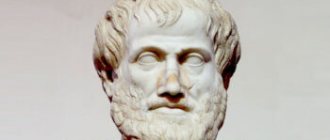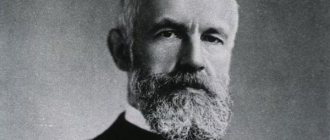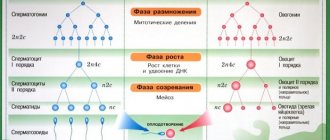Goethe said: When time is ripe, apples fall simultaneously in different orchards.
The time was ripe for determining the status of psychology as an independent science, and then several programs for its development emerged almost simultaneously. They differently defined the subject, method and tasks of psychology, the vector of its development of psychology as an independent science, and then, almost simultaneously, several programs for its development took shape. They defined the subject, method and tasks of psychology, and the vector of its development in different ways.
1.Wuvdt: psychology – the science of direct experience
2.Brentano: psychology as the study of intentional acts
3. Sechenov: the doctrine of the reflex nature of the psyche
Vuvdt: psychology - the science of direct experience
The greatest success fell to W. Wundt (1832-1920). He came to psychology from physiology (at one time he was Helmholtz’s assistant) and was the first to begin collecting and combining into a new discipline what had been created by various researchers. Having given it the ancient name of psychology, he, trying to part with its speculative past, attached to this name the epithet - physiological. “Fundamentals of Physiological Psychology” (1873-1874) was the name of his monumental work, perceived as a body of knowledge about the new science. Having organized the first special psychological institute in Leipzig (1875), he took up topics borrowed from physiologists - the study of sensations, reaction times, associations, psychophysics. It was a bold undertaking to undertake the analysis of a vast field of mental phenomena with the help of instruments and experiments. Young people from many countries began to flock to Wundt. Returning home, they created a din of laboratories similar to those in Leipzig.
Experts in human souls were once called psychologists. But psychologists by profession appeared only after Wundt.
Historians have calculated that 136 Germans, 14 Americans, 10 Englishmen, 6 Poles, 3 Russians, 2 Frenchmen went through Wundt’s school. She became the main nursery of the first generation of experimental psychologists.
Interesting
“Direct experience” was recognized as a unique subject of psychology, not studied by any other discipline. The main method is introspection: the subject’s observation of processes in his consciousness. Introspection was understood as a special procedure that required special long-term training.
With ordinary self-observation, inherent in every person who is able to give an account of what he perceives, feels or thinks, it is extremely difficult to separate perception as a mental process from the perceived real or imagined object. It was believed that this object was given in external experience. The subjects were required to abstract themselves from everything external in order to find the initial elements of internal experience, to get to the primary “fabric” of consciousness, which was considered to be a retinue of sensory (sensory) “threads.”
Interesting
When the question arose about more complex mental phenomena, where thinking and will came into play, the helplessness of Wundt's program was immediately revealed.
If sensation could be explained within the standards accepted by scientific, causal thinking (as the effect of a stimulus on a bodily organ), then the situation was different with volitional acts. Instead of being causally explained, they themselves were accepted by Wundt as the final cause of the processes of consciousness and the primary spiritual force. Thus, the former natural scientist Wundt became a supporter of the philosophy of voluntarism (from the Latin “voluntas” - will) - a philosophy that considers will the highest principle of existence.
No less miscalculations were revealed when Wundt's students took up the processes of thinking. One of them, O. Küllne (1862-1915), moved to the city of Würzburg and created his own school there. Her program was a development of Wundt's. As before, the subject of psychology was considered the content of consciousness, and the method was introspection. The subjects were instructed to solve mental problems while observing what was happening in their consciousness. But the most sophisticated introspection could not find those sensory elements of which, according to Wundt’s prediction, the “matter” of consciousness should consist. Wundt tried to save his program with an angry remark that mental actions, in principle, are not subject to experiment and therefore must be studied from cultural monuments - language, myth, art, etc. Thus, the version of “two psychologies” was revived: experimental, related in its method to the natural sciences, and another psychology, which instead of this method interprets the manifestations of the human spirit.
This version received support from a supporter of another version of the “two psychologies”, philosopher V. Dilthey. He separated the study of connections between mental phenomena and the physical life of the organism from their connections with the history of cultural values. He called the first psychology explanatory, the second understanding.
By the end of the 19th century, the enthusiasm that Wundt's program had once awakened had dried up. Its understanding of the subject of psychology, studied using the subjective experimental method, has forever lost its credit. Many of Wundt's students broke with him and took a different path.
The work done by Wundt's school laid the foundations of experimental psychology. Scientific knowledge develops not only by confirming hypotheses and facts, but also by refuting them. Wundt's critics were able to gain new knowledge by building on what he had gained. Leo Tolstoy, listing the names of those who “work for scientific truth,” named Wundt along with Darwin and Sechenov.
History[edit | edit wiki text]
Main article: History of psychology
Domestic psychologist S. L. Rubinstein at the time of 1940 characterized psychology from a historical point of view as follows [13]:
“Psychology is both a very old and a very young science - it has a 1000-year past behind it, and, nevertheless, it is still in the future. Its existence as an independent scientific discipline dates back only decades, but its main problems have occupied its philosophical thought for as long as philosophy has existed. Years of experimental research were preceded by centuries of philosophical reflection, on the one hand, and millennia of practical knowledge of people, on the other.”
Antiquity[edit | edit wiki text]
Early ancient authors often paid attention in their work to the problems of human nature, his soul and mind. To date, from the entire spectrum of views of ancient authors, only the classification of temperaments of Hippocrates has reached, although many of Plato’s ideas influenced the development of the philosophical foundations of ideas about the psyche, in particular, the idea of a person as a being torn apart by an internal conflict of motives, was reflected in psychoanalytic ideas about the structure of personality. Like most other sciences, the “grandfather” of psychology can rightly be called Aristotle, who in his treatise “On the Soul” gave a detailed analysis of the subject of psychological research.
Middle Ages[edit | edit wiki text]
Medieval writings on psychology in Europe were generally concentrated on questions of faith and reason, and Christian philosophers, starting with Thomas Aquinas, borrowed ideas from Aristotle
. Among the Eastern scientists, Ibn Sina (Avicenna) paid attention to psychological issues.
New time[edit | edit wiki text]
Rudolf Gocklenius
In 1590, Rudolf Gocklenius first used the term "psychology" to refer to the science of the soul. His contemporary Otto Kasmann is considered the first to use the term “psychology” in the modern scientific sense.
Representatives of modern times (for example, Rene Descartes) believed that the body and soul have a different nature - this was a new look at the problem of psychology. “The soul and body live and act according to different laws and have different natures,” wrote Descartes.
XVIII century[edit | edit wiki text]
On August 3, 1795, the British royal astronomer Neville Maskelyne first discovered errors made by his assistant David Kinnbrook in the calculations. Kinnbroek was fired, but error analysis by another astronomer, Friedrich Bezzel, initiated the systematic study of reaction times, individual differences, and mental chronometry .
) as criteria for cognitive processes.
XIX century[edit | edit wiki text]
Wilhelm Wundt
The nineteenth century became for psychology the century of its gradual emergence as a scientific discipline, the separation of relevant areas from philosophy, medicine, and exact sciences.
Ernst Weber explores the dependence of the intensity of sensations on the intensity of the stimuli that cause them.
Hermann Helmholtz explores the nervous system as the basis of the psyche, formulates ideas about “automatic conclusions” that underlie the perception of space.
However, the main name in the history of the formation of psychology as a science is Wilhelm Wundt. A student and colleague of Helmholtz, Wundt in 1879 opened the world's first psychological laboratory, in which studies of the phenomena of consciousness took place using the method of introspection. This year is considered the year of birth of psychology as a science.
XX century[edit | edit wiki text]
The first decades[edit | edit wiki text]
The very beginning of the twentieth century was marked by rapid growth in several directions. On the one hand, psychoanalysis is actively developing - a school of psychotherapy, originally based on the works of Sigmund Freud, in which a person was described as a system of several independent personality structures fighting with each other - It (Id), I (Ego), Super-I (Superego). ). In this conflict, the It represents the biological needs of a person, of which psychoanalysts paid the main attention to sexual needs, and the Super-Ego represents the requirements of society and culture. The development of this school had a strong influence not only on practice, but also on science, forcing scientists to pay attention to phenomena that are beyond consciousness, to the unconscious determinants of mental activity. The ideas of Sigmund Freud's psychoanalysis were criticized, developed and expanded in various areas of depth psychology, mainly by Freud's former colleagues such as Alfred Adler (individual psychology) and Carl Gustav Jung (analytical psychology), and later by neo-Freudians such as Erich Fromm, Karen Horney, Harry Stack Sullivan, Jacques Lacan and others.
In the USA, behaviorism is actively developing - a school of psychology founded by J. Watson, based on the works of I. P. Pavlov and E. Thorndike on learning. Behaviorists followed the positivist requirement to exclude from the consideration of science all phenomena other than those directly observable. A person was viewed as a “black box” into which stimuli enter and reactions to these stimuli come out.
Gestalt psychology is developing in Germany (M. Wertheimer, K. Koffka, W. Köhler), which is a further development on the path of studying the phenomena of consciousness. Unlike their predecessors, the Gestaltists did not try to identify the “bricks” from which consciousness is built; on the contrary, they believed that their main law was that “the whole is always greater than the sum of its parts.” Within the framework of this school, many phenomena of perception and thinking were discovered.
The First World War stimulated the development of applied aspects of psychology, primarily psychodiagnostics, as the army needed a means of assessing the capabilities of soldiers. Intelligence tests are being developed (A. Binet, R. Yerkes).
1930-1940s[edit | edit wiki text]
The Nazis came to power in Germany, as a result of which many psychologists (among whom there were many Jews) were forced to emigrate to the United States. Gestalt psychology practically ceases to exist, but K. Lewin and the followers of the Gestaltists become the main figures of American social psychology. Nevertheless, thinkers such as Carl Jung and Martin Heideger remained working in Nazi Germany. Jung continues to develop his teaching about the collective unconscious; in 1934 he released one of his fundamental works, Archetypes and the Collective Unconscious
».
Among behaviorists, on the one hand, attempts begin, while maintaining a natural scientific foundation, to introduce intrapsychic variables into the explanation of behavior (E. Tolman, K. Hull), on the other hand, B.F. Skinner develops “radical behaviorism”, developing the theory of operant learning .
J. Piaget publishes the results of studies of thinking in which similar types of errors were found in children of the same age, which are practically no longer found in older children.
Psychological and psychotherapeutic practice is actively developing. Various areas of depth psychology continued to develop, and forms of psychotherapy alternative to psychoanalysis (Gestalt therapy, etc.) were being formed.
L. S. Vygotsky formulates the basic principles of cultural-historical psychology based on Marxism. Within the framework of this direction, the need was postulated to study personality directly in the process of development, occurring under the influence of history and culture. On the basis of this direction, the theory of activity was subsequently built.
The resolution “On pedological perversions in the system of People's Commissariat for Education” (1936), which eliminated pedology, practically froze the development of psychological science in the USSR for several decades.
The Second World War causes a new surge in the activity of psychologists in the field of applied technologies. Particular attention is paid to social psychology and ergonomics.
1950-1960s[edit | edit wiki text]
These decades are the era of the flourishing of psychological science, active growth in many directions. In modern textbooks, most of the material is devoted to experiments and research conducted during this period.
The theory of behaviorism could not provide answers to many questions that developing industry and military technology posed to science. The development of the most effective forms of presenting information on control panels of complex devices and other tasks required active study of not only simple reactions to stimuli, but the complex mechanisms underlying perception. As a result of such a request, a field begins to develop that will later be called “cognitive psychology” - D. Broadbent conducts his research into the mechanisms of attention, publishes the famous article about “The Magic Number Seven Plus or Minus Two” by J. Miller.
Behavior modification techniques based on the theory of behaviorism are actively developing. J. Volpe develops a technique of systematic desensitization, which turns out to be very effective in the treatment of various types of phobias.
Against this background, humanistic psychology and psychotherapy appear as an attempt to overcome the reduction of man to an automaton or animal (the theories of behaviorism and psychoanalysis). Humanistic psychologists propose to consider a person as a being of a higher level, endowed with free will and the desire for self-actualization.
There is a rapid development of social psychology in the United States. Solomon Ash, Muzafer Sherif, Stanley Milgram, Leon Festinger and other famous psychologists conduct their famous studies.
In the late 60s, along with the growing popularity of New Age culture, psychology was strongly influenced by mysticism; In the wake of the success of research into psychedelic substances and new areas of consciousness, transpersonal psychology emerges, and a number of schools of personal growth training are developing, some of which eventually turn into religious cults: (Scientology, Lifespring).
In 1966, the departments of psychology were created at Moscow State University and Leningrad State University, as well as the department of psychiatry and medical psychology at RUDN University, which demonstrates the end of 30 years of persecution of psychologists. To a significant extent, this was due to the emergence of demand for psychologists in production and in the army. Engineering psychology is actively developing in the USSR. However, due to objective reasons, domestic psychology has to remain extremely ideological in accordance with Marxist-Leninist constructs - this circumstance will give its further development a certain specificity. To this day, Marxist-Leninist theories (see reflection theory) one way or another retain influence on the training program for psychologists in some Russian universities.
1970-1980s[edit | edit wiki text]
There is a rapid growth of cognitive psychology, which followed the path of gradual refutation of its initial postulates about the essence of the human psyche as an information processing system with limited bandwidth. During this period, psychology established active connections with linguistics, which became inevitable after the “Chomskyan revolution”; psycholinguistics emerges.
In other areas of psychology, there is a stable growth and accumulation of knowledge, at the same time, the feeling of the “eternal crisis” of psychological thought is again intensifying, since none of the current directions gives hope for the imminent appearance of a truly complete theory that explains human behavior.
Modernity[edit | edit wiki text]
Currently, methods based on various types of tomography have become important in the study of the psyche. The use of tomography makes it possible to determine the structure and study the functioning of neural networks. To study the connections between the functioning of the psyche for various types of mental activity under various conditions with the structure and functioning of the brain, functional magnetic resonance imaging is used, which makes it possible to determine the activation of brain regions during its normal functioning (see, for example, [14]). To study mental processes at the molecular level, including metabolism, transport of substances, ligand-receptor interactions, gene expression, etc., positron emission tomography (PET) is used (see, for example, [15]). In particular, PET is used to study the participation of various neurotransmitters in neurophysiological and mental processes.
Brentano: psychology as the study of intentional acts
At the same time as Wundt, the philosopher Franz Brentano (1838-1917) proposed his program for a new psychology. It was outlined in his work “Psychology from an Empirical Point of View” (1874). The subject of psychology, just like Wundt, was considered consciousness. However, its nature was thought to be different.
According to Brentano, the field of psychology is not the content of consciousness (sensations, perceptions, thoughts, feelings), but its acts, mental actions, thanks to which the content appears. The color or image of an object is one thing. Another is the act of seeing color or judging an object. The study of acts is a unique sphere unknown to physiology. The specificity of an act is in its intention, its focus on some object to which this act is chained.
Brentano's concept became the source of several branches of Western psychology. It gave impetus to the development of the concept of mental function as a special activity of consciousness, which was not reduced to either elements or processes, but was considered initially active and objective.
Psychological aspects of development
We will see the psychological aspects of development, a number of its branches in which the principle of development is implemented
Developmental psychology is a branch of psychological science that studies the facts and patterns of human development and the age-related dynamics of his psyche. The object of study of developmental psychology is a developing, normal, healthy person who changes in ontogenesis. Developmental psychology focuses on age-related changes in people's behavior and seeks to explain these changes and identify patterns in how people acquire experience and knowledge. It focuses on "the various forms of mental organization that characterize certain periods of a person's life course."
Developmental psychology is aimed at studying holistic mental development “over the entire space of human life from birth to death,” and its ultimate goal is the study of “a changing, developing person in a changing world.”
The subject of study of the psychology of old age is age periods of development, the causes and mechanisms of transition from one age period to another, general patterns and trends, the pace and direction of mental development in the process of ontogenesis.
One of the central problems of developmental psychology - the problem of learning and mental development and their interdependence - is widely discussed by psychologists who are searching for reliable criteria for mental development and identifying the conditions under which effective mental development is achieved in the learning process.
Main directions of psychology
Throughout time, new directions in psychology and approaches to humans have been created.
Today, many of them are actively used and are selected for a specific person and individual situation.
Probably everyone knows that the theory of psychoanalysis was created by Freud .
The main points are that the main problems and causes of behavior are hidden in the unconscious .
And the main stage in the formation of individuality occurs in childhood. Libido and fear of death are factors that often move a person. This method is suitable for the treatment of neuroses and old psychological traumas.
Gestalt psychology claims that you need to perceive the picture holistically, and not split it into separate elements, as the direction described above does. That is, look not at a specific personality trait, but at the whole person and the living conditions around him.
There are concepts of open gestalt, when some situation has not ended acceptably. Therefore, during sessions they play it, discuss it and close it so as not to disturb the client.
Hypnosis is used to bring a person into an altered consciousness and become closer to the unconscious. During the session, they try to extract the causes of the problem, negative factors that the client does not want to share in a normal dialogue. Positive attitudes can also be instilled. For example, that everything is fine and the person calms down.
Client-centered psychology in its name indicates that the main role in the session is given to the client. That is, he can help himself, only to do this he needs to be carefully directed in the right direction.
Therefore, most of the attention is directed to establishing a trusting relationship between the psychotherapist and his interlocutor, so that he trusts and feels confident.
Art psychology tells how, with the help of creativity, a person can pour out his negative emotions and feelings, and thereby relieve himself of heaviness. Also, the psychotherapist can give tasks and interpret their implementation (text, drawing, modeling), together with the client, study the problem hidden inside him, and find a way out.
The cognitive-behavioral direction deals with the correction of the client’s erroneous thinking. A psychologist explains what a person is doing (or thinking) wrong. Gives examples, arguments, recalls various similar situations. It also shows how you can live by the new rules.
What psychology studies: features of the discipline
Psychology is a science that studies human will, attention, consciousness, memory functions and behavioral characteristics. Memory can be called an analogue of a storage device, which can be either permanent or short-term. In modernized psychology, it is customary to distinguish the following types of memory:
- Emotional. It is human nature to retain memories of experienced feelings over a long period of time.
- Figurative. An image once seen can emerge in memory even several decades later.
- Tangible, including information about tactile contact.
- Motor. With its help, the driver of the vehicle brings the control of the vehicle to automaticity, and the dancer flawlessly performs a once memorized sequence of movements.
- Auditory and visual.
Memory is a complex, difficult process that is necessary for the transfer of knowledge and accumulated experience from generation to generation. However, in the case of painful memories, a person's subconscious mind may erase them in order to minimize the impact of stress. Equally difficult to understand is the concept of attention, which allows the subject to concentrate on observing or performing tasks that require special care.
Through lengthy analytical work and practical experiments, psychologists were able to identify the following types of attention:
- Switchable (fickle attention).
- Distributed (allowing you to control several processes simultaneously).
- Selective (when it is possible to select one of the objects for observation).
Psychology is a science that studies the causes and factors due to which certain patterns of perception and patterns in the behavior of humans and animals were formed. The discipline is distinguished by a very wide range of interests, including the formation of mental processes of the individual (cognitive abilities, perception at the level of sounds, smells and colors), mental properties (such as character, temperament, activity), conscious and unconscious processes and the laws of higher nervous activity .









